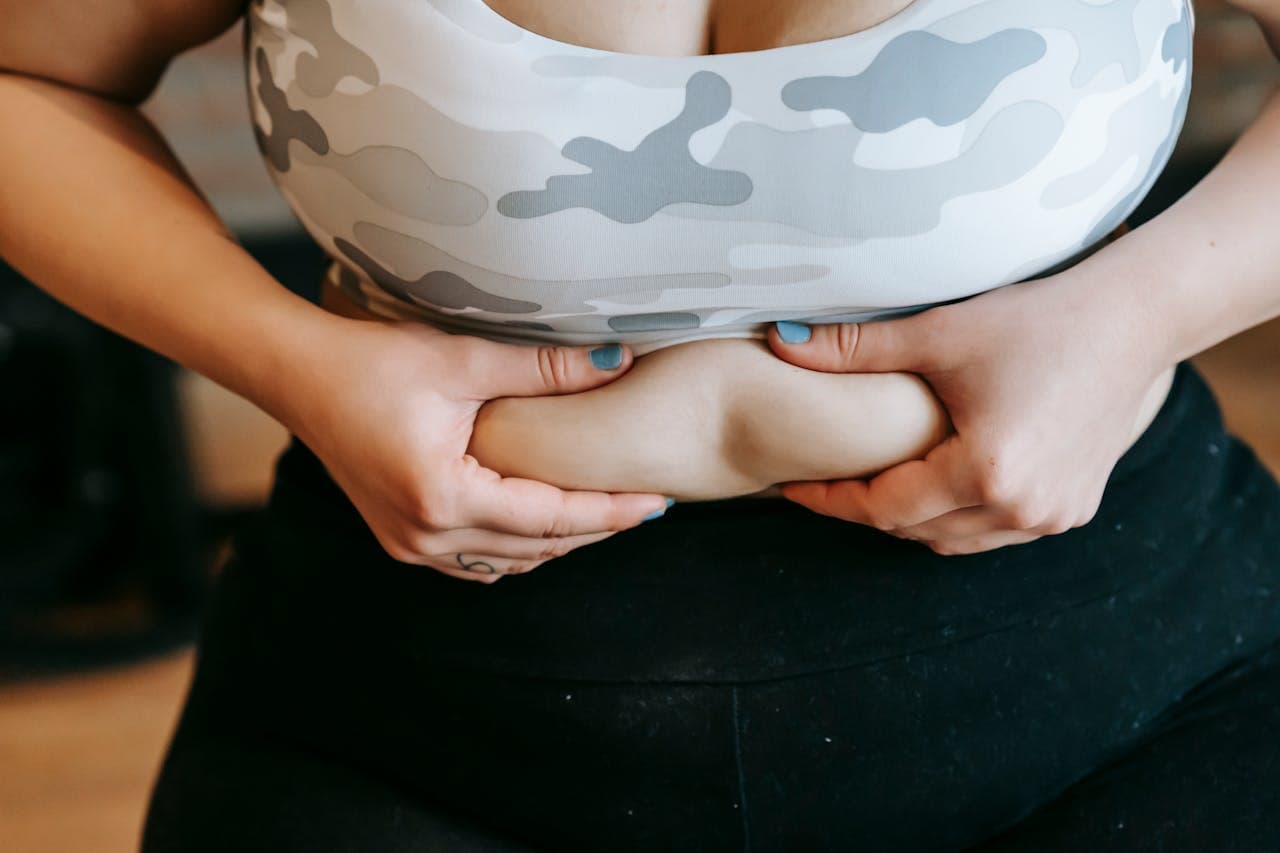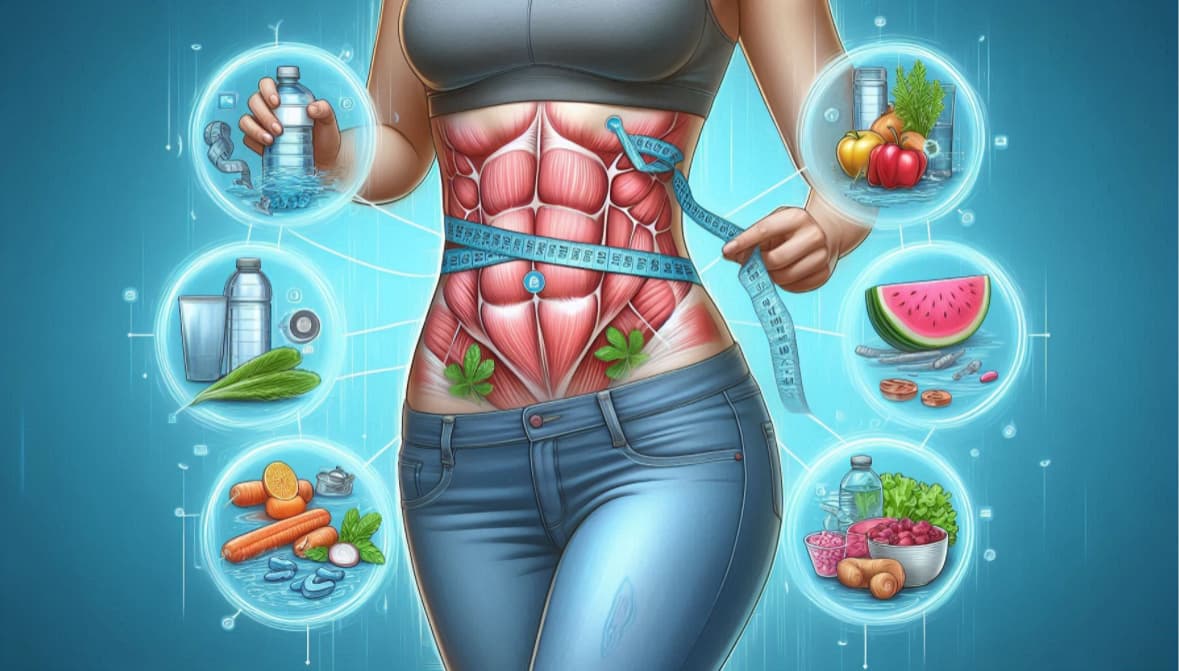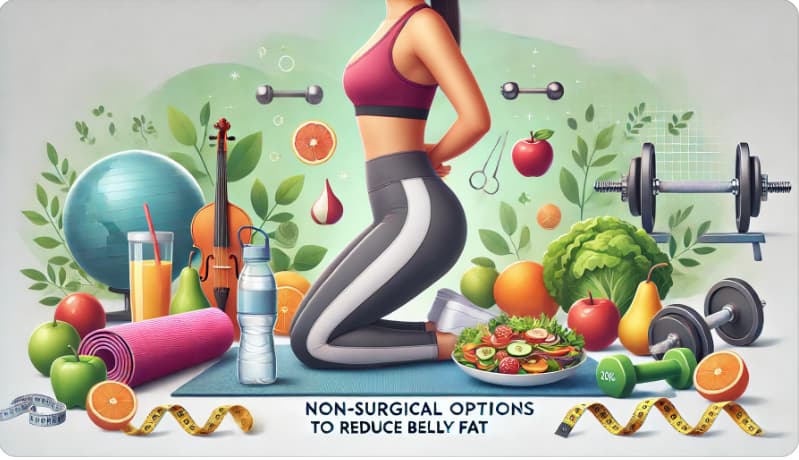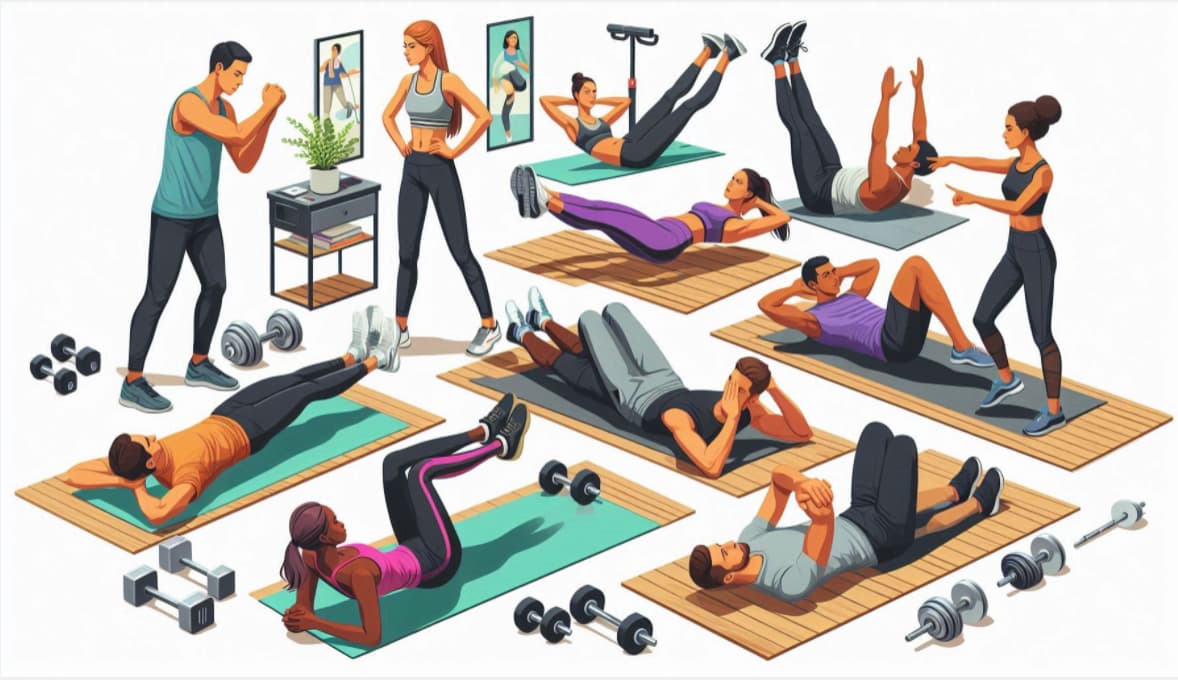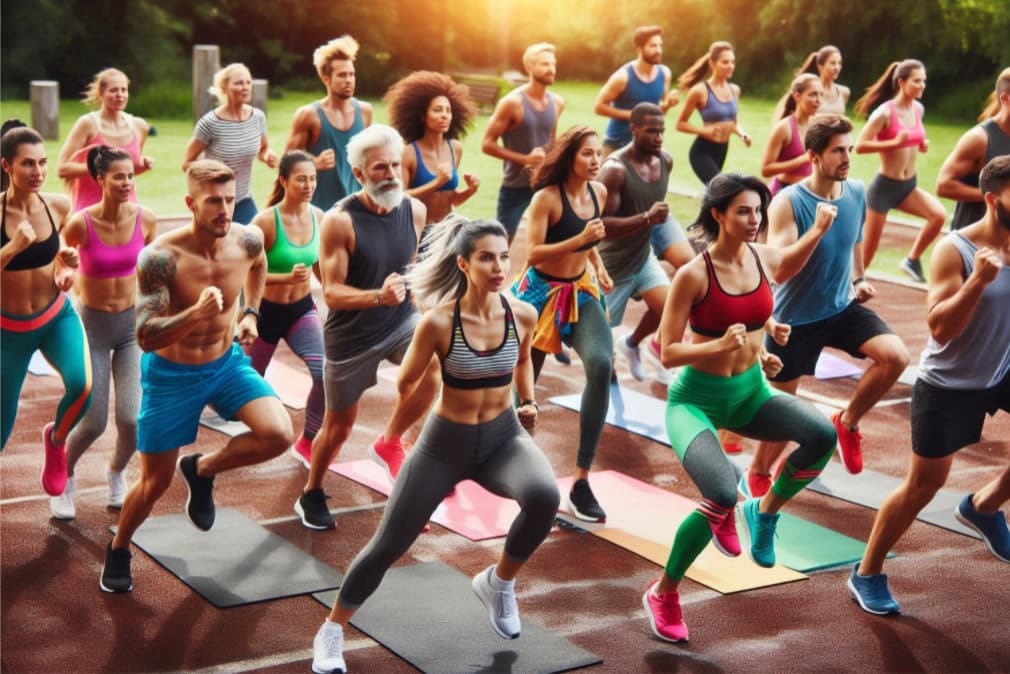Apron Belly? Welcome to the journey of reclaiming a healthier and more confident you! If you’ve been searching for effective ways to address that stubborn apron belly, you’re in the right place.
In this guide, we’ll delve deep into the causes of an apron belly, the health risks associated with it, and most importantly, a detailed plan featuring exercises tailored to help you bid farewell to excess belly fat.
But first, why should you be concerned about apron belly?
1. What is an apron belly?
An apron belly, also known as a panniculus or abdominal apron, is a term used to describe the excess skin and fat that hangs down over the lower abdomen.
This condition can affect individuals of various body shapes and sizes.
Apron belly, often caused by factors like weight gain, pregnancy, aging, and metabolism, goes beyond cosmetic concerns.
It’s associated with various health risks, including diabetes, cardiovascular diseases, back pain, and posture problems.
The good news is that you can take control of your health by incorporating targeted exercises into your routine.
In this article, we will delve into what an apron belly is, its causes, symptoms, and potential solutions.
A. Causes of Apron Belly:
Weight Gain: Significant weight gain, whether due to overeating, a sedentary lifestyle, or other factors, can lead to the accumulation of fat in the abdominal region, resulting in an apron belly.
Pregnancy: The stretching of the abdominal muscles and skin during pregnancy can contribute to the development of an apron belly. Sometimes, the abdominal muscles may not fully regain their tone post-pregnancy.
Aging: As we age, the skin loses elasticity, and the abdominal muscles may weaken. This can lead to sagging skin and the formation of an apron belly.
B. Symptoms of Apron Belly:
Excess Skin: One of the primary symptoms is the presence of loose, hanging skin in the lower abdominal area.
Stubborn Fat Deposits: Accumulation of stubborn fat that is resistant to diet and exercise efforts.
Discomfort and Skin Irritation: The excess skin may lead to discomfort, chafing, and skin irritation, particularly in hot or humid conditions.
C. Health Implications:
Increased Risk of Infections: The folds of excess skin may create an environment conducive to bacterial or fungal infections, necessitating proper hygiene practices.
Emotional Impact: Apron belly can have psychological effects, affecting body image and self-esteem. Individuals may feel self-conscious or struggle with their confidence.
D. Prevention and Management:
Healthy Lifestyle: Adopting a balanced diet and engaging in regular physical activity can prevent or reduce the risk of developing an apron belly.
Gradual Weight Loss: If overweight, aim for gradual weight loss to allow the skin to adapt and reduce the likelihood of sagging.
Strengthening Exercises: Incorporating core-strengthening exercises can help tone the abdominal muscles and improve overall body composition.
E. Medical Interventions:
Surgical Procedures: In cases where excess skin and fat are significant, individuals may explore surgical options such as a tummy tuck (abdominoplasty).
These procedures involve the removal of excess skin and tightening of the abdominal muscles.
F. Consultation with Healthcare Professionals:
Individuals concerned about their apron belly should consult with healthcare professionals, including dermatologists, plastic surgeons, or fitness experts, to explore personalized solutions and guidance.
Don’t let apron belly define your health! Learn more about your condition today—spots for our exclusive webinar are filling fast!
2. How to Get Rid of Apron Belly
Getting rid of an apron belly requires a multifaceted approach that involves a combination of lifestyle changes, targeted exercises, and sometimes medical interventions.
We’ll delve deep into effective strategies to help you achieve a flatter and more toned abdominal area.
1. Healthy Eating Habits:
- Balanced Diet: Focus on a well-balanced diet that includes lean proteins, whole grains, fruits, and vegetables. Limit the intake of processed foods, sugary snacks, and high-fat meals.
- Portion Control: Be mindful of portion sizes to avoid overeating. Consuming smaller, frequent meals throughout the day can help regulate blood sugar levels and prevent excessive calorie intake.
2. Regular Exercise Routine:
- Cardiovascular Exercise: Incorporate aerobic exercises such as brisk walking, running, or cycling to burn calories and promote weight loss.
- Strength Training: Include strength training exercises that target the core muscles, such as planks, leg raises, and Russian twists. Building muscle helps increase metabolism and contributes to a firmer abdominal area.
- HIIT Workouts: High-intensity interval Training (HIIT) can be particularly effective in burning fat and promoting weight loss. Include short bursts of intense exercise followed by periods of rest.
3. Targeted Abdominal Exercises:
- Pelvic Tilts: Lie on your back, bend your knees, and tighten your abdominal muscles while tilting your pelvis upward. Hold for a few seconds and release.
- Crunches and Sit-ups: These classic exercises engage the abdominal muscles and help tighten the core. Ensure proper form to avoid strain on the neck and back.
- Leg Raises: Lie on your back and lift your legs towards the ceiling without bending the knees. Lower them back down without touching the floor to engage the lower abdominal muscles.
4. Hydration and Detoxification:
- Water Intake: Stay adequately hydrated by drinking plenty of water throughout the day. Proper hydration supports metabolism and can aid in weight loss.
- Detoxifying Foods: Include foods that promote detoxification, such as green leafy vegetables, fruits, and herbal teas. These can help eliminate toxins and reduce water retention.
5. Medical Interventions:
- Surgical Options: In cases where excess skin and fat are significant, surgical procedures like a tummy tuck (abdominoplasty) may be considered. Consult with a qualified plastic surgeon to discuss the risks and benefits of such procedures.
6. Mind-Body Practices:
- Stress Management: Chronic stress can contribute to abdominal fat. Practice stress-reducing activities such as meditation, yoga, or deep breathing exercises to promote overall well-being.
Before we dive into the workout regimen, let’s explore non-surgical options to reduce apron belly.
3. Non-Surgical Options to Reduce Apron Belly
Aerobic Activities
Aerobic exercises, such as brisk walking, jogging, or cycling, play a crucial role in burning calories and aiding weight loss. Consider investing in a reliable fitness tracker to monitor your progress and stay motivated.
Strength Training
Building muscle is key to boosting your metabolism and targeting stubborn fat. Incorporate resistance bands or dumbbells into your routine for effective strength training.
Abdominal Exercises
Target the core with specific exercises like planks, sit-ups, and Russian twists. For added support and comfort, use a quality exercise mat.
Balanced Diet
No exercise routine is complete without a healthy diet. Consider a meal plan rich in nutrient-dense foods to support your fitness goals.
Adequate Water Intake
Staying hydrated is crucial for overall health and can aid in weight loss. Invest in a reusable water bottle to ensure you’re getting enough fluids throughout the day.
4. Targeted Exercises for Apron Belly
Embarking on a journey to address an apron belly requires targeted exercises that focus on strengthening the core and promoting overall fat loss.
These exercises, when performed consistently, contribute to toning the abdominal muscles and reducing excess fat in the lower belly.
Let’s delve into the details of each exercise, emphasizing proper form and technique.
1. Squats
Squats are a versatile compound exercise engaging multiple muscle groups, including the core. The provided link directs you to detailed squat instructions and images, offering step-by-step guidance on proper form.
Understanding the mechanics of a squat ensures that you maximize its effectiveness in targeting the apron belly while avoiding unnecessary strain on other muscle groups.
2. Lunges
Lunges are excellent for targeting the lower body and core. The link provides detailed lunge instructions and images, emphasizing variations and proper alignment.
By incorporating lunges into your routine, you engage the muscles in the apron belly area, promoting strength and definition. The resource ensures you perform lunges safely and effectively for optimal results.
3. Deadlifts
Deadlifts are a compound exercise that activates the entire posterior chain, including the core.
Detailed deadlift instructions and images are accessible through the provided link, offering insights into different deadlift variations and correct forms.
Learning the nuances of deadlifts ensures you target the apron belly while fostering overall strength and stability.
4. Push-Ups
Push-ups engage the core muscles while also working the upper body. The link directs you to detailed push-up instructions and images, focusing on proper hand placement and body alignment.
Mastering the push-up form ensures you effectively target the apron belly area and build strength in the entire core.
5. Planks
Planks are a staple for core activation and stability. The provided link offers detailed plank instructions and images, guiding you through variations and correct positioning.
Incorporating planks into your routine strengthens the muscles around the apron belly, promoting endurance and reducing excess fat.
6. Sit-Ups
Sit-ups specifically target the abdominal muscles. The link directs you to detailed sit-up instructions and images, highlighting proper techniques and common mistakes to avoid.
By performing sit-ups correctly, you effectively engage the apron belly muscles, fostering toning and definition.
7. Russian Twists
Russian twists are effective for targeting the obliques and core. The provided link offers detailed instructions and images, focusing on form and variations.
By incorporating Russian twists into your routine, you engage the sides of the apron belly, contributing to a well-rounded approach to abdominal toning.
8. Bicycle Crunches
Bicycle crunches are dynamic and engage multiple muscle groups. The link provides detailed instructions and images, emphasizing proper execution.
Adding bicycle crunches to your routine effectively targets the apron belly area, fostering muscle engagement and fat loss.
9. Side Planks
Side planks target the obliques and help define the waistline. Detailed side plank instructions and images are accessible through the provided link.
Mastering Side planks ensures you engage the sides of the apron belly, promoting a more sculpted and toned appearance.
10. Mountain Climbers
Mountain climbers are a dynamic exercise that elevates the heart rate. The link directs you to detailed mountain climber instructions and images, emphasizing proper form and pace.
By incorporating mountain climbers, you engage the entire core, promoting fat loss in the apron belly region.
Now that we’ve explored targeted exercises, let’s understand the crucial role of cardio and aerobic exercises in your journey to shed that apron belly.
5. Importance of Cardio and Aerobic Exercises
Burning Calories and Weight Loss
Cardiovascular exercises like walking, running, cycling, and swimming are excellent for burning calories and accelerating weight loss. Invest in comfortable running shoes or a swimsuit to make your workouts enjoyable. Exploring non-surgical options? Discover Liv Pure for natural support in reducing your apron belly. Click Here.
Recommended Cardio and Aerobic Activities
- Walking: A simple yet effective exercise. Consider a quality pair of walking shoes.
- Running: Boosts metabolism and burns calories. Invest in running gear for maximum comfort.
- Cycling: Low-impact and great for toning the lower body. Check out biking accessories.
6. Diet and Lifestyle Changes
1. Caloric Intake Reduction
Reducing caloric intake is a fundamental aspect of weight management and achieving a healthier lifestyle. It involves creating a sustainable calorie deficit, where the body burns more calories than it consumes.
The comprehensive guide on caloric intake reduction provides in-depth insights into calculating your daily caloric needs, understanding macronutrients, and establishing realistic calorie reduction goals.
It explores the science behind weight loss, emphasizing the importance of balance to ensure the body receives essential nutrients.
2. Avoidance of Processed Foods
Processed foods are often high in unhealthy fats, sugars, and sodium, contributing to weight gain and other health issues. The link provided directs you to a resource featuring healthy recipe ideas and cooking essentials.
It explores the benefits of preparing meals at home, emphasizes the importance of whole, unprocessed ingredients, and offers creative recipes that cater to various dietary preferences.
By understanding the nutritional value of foods, individuals can make informed choices and cultivate a diet centered on whole, nutrient-dense options.
3. Increased Water Consumption
Staying well-hydrated is essential for overall health and supports weight management. The link directs you to a selection of water bottles designed for all-day hydration.
It further discusses the significance of water in metabolism, appetite control, and skin health.
The resource provides recommendations for tracking water intake, offers tips on infusing water with flavors naturally, and emphasizes the importance of consistency in maintaining proper hydration levels.
4. Selection of Complex Carbs
Choosing complex carbohydrates over simple sugars is crucial for sustainable energy levels and weight control.
The provided link directs you to a resource highlighting whole-grain products and healthy carbohydrate options.
It explores the benefits of complex carbs, such as fiber content and slower digestion, and provides practical tips for incorporating them into daily meals. Understanding the role of carbohydrates in a balanced diet is essential for making informed food choices.
5. Stress Reduction Techniques
Stress can significantly impact both mental and physical well-being, influencing weight management. The link leads to stress-relief products or mindfulness apps that offer effective techniques for stress reduction.
It explores various mindfulness practices, relaxation exercises, and stress-management tools that individuals can integrate into their daily routines.
Understanding the connection between stress and weight gain is crucial for implementing holistic lifestyle changes.
6. Incorporating Enjoyable Activities
Physical activity doesn’t have to be a chore; it can be enjoyable and sustainable. The link provided directs you to fitness accessories or gear for enjoyable workouts.
It explores the importance of finding activities that bring joy, discusses the benefits of incorporating variety into workouts, and suggests accessories that enhance the fitness experience.
Making exercise enjoyable increases the likelihood of long-term adherence, contributing to overall health and weight management.
7. How can you ease discomfort caused by an apron belly
Easing discomfort caused by an apron belly involves a combination of lifestyle adjustments, self-care practices, and, in some cases, medical interventions.
Here are detailed suggestions on how to alleviate discomfort associated with an apron belly:
1. Hygiene and Skincare:
- Keep the Area Clean: Regularly clean the skin folds beneath the apron belly to prevent bacterial or fungal infections. Use a gentle, fragrance-free soap and pat the area dry after washing.
- Use Antifungal Creams: If irritation or redness occurs, consider using over-the-counter antifungal creams to address potential skin issues.
2. Moisture Management:
- Powder Application: Applying talcum or cornstarch powder to the skin folds can help absorb moisture and reduce friction, decreasing the likelihood of chafing.
- Choose Breathable Fabrics: Opt for loose-fitting, breathable clothing to minimize moisture buildup and provide better air circulation.
3. Supportive Undergarments:
- Wear Supportive Underwear: Invest in well-fitting, supportive underwear or abdominal binders to lift and hold the excess skin, providing relief from discomfort and reducing the risk of skin irritation.
4. Maintain a Healthy Weight:
- Gradual Weight Loss: If applicable, aim for gradual and sustainable weight loss through a balanced diet and regular exercise. This can reduce the size of the apron belly and alleviate pressure on the abdominal area.
5. Core-Strengthening Exercises:
- Engage in Gentle Exercises: Incorporate low-impact exercises that strengthen the core muscles without causing strain. Activities like swimming, walking, or yoga can be beneficial.
- Consult a Physical Therapist: A physical therapist can provide targeted exercises to improve core strength and stability while minimizing discomfort.
Conclusion
An apron belly is a common condition that can arise from various factors, impacting both physical and emotional well-being.
Understanding the causes, symptoms, and available solutions is essential for those seeking to address or prevent this condition.
Whether through lifestyle changes, targeted exercises, or medical interventions, individuals can find approaches that suit their needs and contribute to a healthier and more confident lifestyle.
Frequently Asked Questions
1. Can exercise get rid of an apron belly?
A. Exercise can help reduce an apron belly by targeting the underlying muscles and promoting fat loss. Core-strengthening exercises, combined with cardiovascular workouts, can improve muscle tone and overall body composition.
While exercise alone may not eliminate an apron belly, it can contribute significantly to its reduction.
2. How do I get rid of my overhang belly?
A. Getting rid of an overhanging belly involves a combination of healthy eating, regular exercise, and targeted core workouts.
Adopting a balanced diet, engaging in cardiovascular exercises, and incorporating strength training specifically focused on the abdominal muscles can help reduce excess fat and tighten the skin over time.
3. How can I reduce my saggy belly?
A. To reduce a saggy belly, a holistic approach is essential. Maintain a healthy lifestyle with a balanced diet and regular exercise, including both cardio and strength training.
Additionally, staying hydrated, moisturizing the skin, and avoiding rapid weight loss can contribute to the gradual improvement of skin elasticity.
4. How do you get rid of hanging belly skin?
A. Addressing hanging belly skin involves a combination of factors. Gradual weight loss, proper hydration, and exercises targeting the core muscles can help.
Additionally, consider using moisturizers to improve skin elasticity and consult with healthcare professionals for personalized advice.
5. Apron belly exercises for beginners
A. For beginners, start with gentle exercises that engage the core muscles. Pelvic tilts, seated leg lifts, and modified planks are excellent choices.
Gradually progress to more challenging exercises as strength and endurance improve, but always prioritize proper form to avoid injury.
6. Apron belly exercises at home
A. Effective apron belly exercises at home include leg raises, seated knee tucks, standing side crunches, and modified mountain climbers.
These exercises require minimal equipment and can be incorporated into a home workout routine. Consistency is key for noticeable results.
Recent Posts
- Metabolic Workouts for Women: Igniting Fitness and Wellness
- Meat and Fruit Diet: A Flavorful Feast for Health and Wellness
- High Volume Low-Calorie Foods: Dive into High-Volume Delights
- Whole Foods Cookies: A Comprehensive Guide


